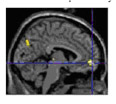Archived Content
The National Institute of Mental Health archives materials that are over 4 years old and no longer being updated. The content on this page is provided for historical reference purposes only and may not reflect current knowledge or information.
Depression Patients’ Brain Circuitry Makes Them Vulnerable to Relapse
• Science Update

Yellow area to right
indicates depression
Using brain imaging, NIMH researchers have produced direct evidence that people prone to depression -- even when they're feeling well -- have abnormal mood-regulating brain circuitry. This makes them vulnerable to relapse when levels of certain key brain chemical messengers plummet.
Wayne Drevets, M.D., of the NIMH Mood and Anxiety Disorders Program, Gregor Hasler, M.D., now at University Hospital, Zurich, Switzerland, and colleagues reported on their positron emission tomography (PET) scan study in the May 2008 Archives of General Psychiatry.
Indirect evidence had suggested that people with histories of depression have such a "trait abnormality" in brain systems that communicate using the brain chemicals dopamine and norepinephrine. Decreased dopamine activity, in particular, is thought to be associated with depression.
To test this directly and identify any brain circuit abnormalities, the researchers studied 15 un-medicated subjects in remission who had a history of depression by giving them a drug that temporarily depleted their brains of dopamine and norepinephrine.
These subjects experienced an increase in depression symptoms and a decrease in the ability to feel pleasure. PET scans showed that this was accompanied by an increase in activity in a depression-implicated brain circuit. By contrast, activity decreased or remained unchanged in the same brain circuit with depletion in 13 healthy participants who experienced only minor mood effects. Activity in specific brain structures in the circuit corresponded with a set of mood effects (see graphics below).
Dopamine normally functions in the circuit to inhibit runaway activity of emotion hubs deep in the brain by higher brain centers. Depleting dopamine effectively takes the brakes off the emotional hubs in depression-prone individuals - hence the increased circuit activity, the researchers suggest.
"The subjects in remission from depression experienced symptoms qualitatively similar to those they had during major depressive episodes," said Drevets. "Our findings suggest that depression is associated with persistent vulnerability for developing such responses to reduced dopamine and norepinephrine neurotransmission."
Depressive Symptoms

Increased activity in an area in the lower middle of the front of the brain (yellow, where lines intersect) correlated with depression symptoms experimentally induced by a drug that depleted dopamine and norepinephrine.
Source: Wayne Drevets, M.D., NIMH Mood and Anxiety Disorders Program
Loss of Ability to Experience Pleasure

Source: Wayne Drevets, M.D., NIMH Mood and Anxiety Disorders Program
Reference
Hasler G, Fromm S, Carlson PJ, Luckenbaugh DA, Waldeck T, Geraci M, Roiser JP, Neumeister A, Meyers N, Charney DS, Drevets WC. Neural response to catecholamine depletion in unmedicated subjects with major depressive disorder in remission and healthy subjects. Arch Gen Psychiatry. 2008 May;65(5):521-31.PMID: 18458204
